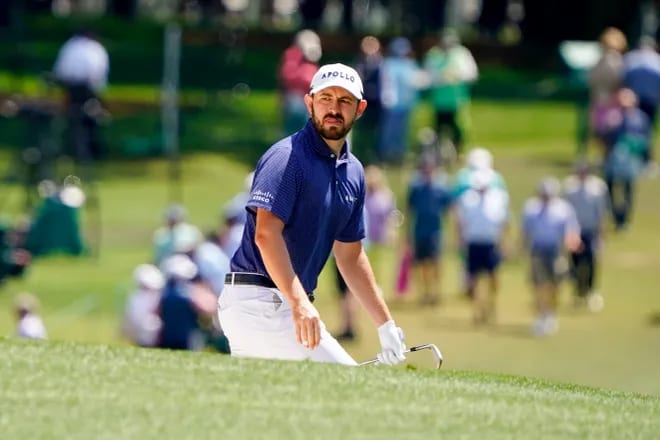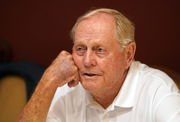
USA Today via Reuters
Apr 11, 2024; Augusta, Georgia, USA; Patrick Cantlay watches his shot out of a bunker on no. 1 during the first round of the Masters Tournament. Mandatory Credit: Katie Goodale-USA TODAY Network

USA Today via Reuters
Apr 11, 2024; Augusta, Georgia, USA; Patrick Cantlay watches his shot out of a bunker on no. 1 during the first round of the Masters Tournament. Mandatory Credit: Katie Goodale-USA TODAY Network
Just last week, the PGA Tour announced the latest innovation to tackle the much-talked-about pace of play. The technology implemented by NBC has been displaying the slowest players of the round during the broadcast. And considering Patrick Cantlay’s history of slow plays, it was no surprise he topped the slow play leaderboard at Caves Valley.
Watch What’s Trending Now!
“The Lowry-Cantlay group is going on the clock right now to be timed,” said Dan Dusbabek, a PGA Tour official. As Dusbabek highlighted, NBC rolled out a new graphic showing just how far behind “time par” Patrick Cantlay and Shane Lowry’s group was falling during the BMW Championship. It was the first time a broadcast explicitly called out a specific group in this way, and the golf world took notice.
In a recent press conference at the TOUR Championship, Cantlay finally addressed the controversy. “I talked to a lot of guys last week. The course was playing really tough, so almost every group was behind time par,” he explained. When asked if he felt singled out by the broadcast, Cantlay acknowledged it: “Yeah, obviously I’m not in control of the broadcast or what kind of stuff they put on there.”
ADVERTISEMENT
After officials placed the group on the clock, Cantlay and Lowry completed their round without issue. Neither incurred the mandatory two “bad times” that would trigger a one-shot penalty. For viewers at home, the graphic provided a rare glimpse into the Tour’s slow-play enforcement, showing exactly how far behind the expected pace the group was over six holes. At the end of the tournament, Cantlay finished at T30 while Lowry stood at T23.
For some, the clock may come as an annoying reminder, but many consider it necessary. “I think we’re starting to need a new word to talk about this pace-of-play issue, and it’s ‘respect’ — for your fellow competitors, for the fans, for broadcasts, for all of it. It’s just got to get better,” said analyst Dottie Pepper while criticizing the pace of play during this year’s Farmers Insurance Invitational.
Patrick Cantlay strikes back at criticism of slow play in Masters.
See his full comments: https://t.co/AyUZbRoCBs pic.twitter.com/rHIqs8m2Hi
— Golf Digest (@GolfDigest) April 12, 2023
ADVERTISEMENT
The graphic aligned with broader PGA Tour experiments on pace of play, including trial rules on the PGA Tour Americas that impose a one-shot penalty for the first “bad time.” The goal is to speed up play, level the field between fast and slow groups, and make tournament coverage more engaging. While Patrick Cantlay might have felt cornered, the graphic in retrospect was largely symbolic—a public slap on the wrist.
Even world number one Scottie Scheffler felt the pressure of pace-of-play enforcement. He and Robert MacIntyre were in the final group of the third round when they were warned about the clock. “It’s frustrating. I’m not really sure how that’s possible,” Scheffler said after his round.
ADVERTISEMENT
The Tour’s push for faster play is clear — but the players’ perspective reminds fans that not every second lost is avoidable. Courses play differently each day, pressure mounts, and sometimes rounds naturally slow down. Nevertheless, Cantlay is locked in for his game. “I’m not really worried about it. I’m trying to make the lowest score out there,” he concluded in the press conference.
But this is not the first time he’s been accused of slow plays.
Top Stories
Tour Pro Hit With Brutal 5-Month Punishment Only 11 Days After Celebrating Career Feat

Jack Nicklaus’ Former Company Announces Bankruptcy After $50M Lawsuit Defeat

Nelly Korda Makes Personal Request to LeBron James After He Showed Support for LPGA Pro

Support Pours in as PGA Tour Pro Bursts Into Tears Over Strict New Policy

Another U.S. University Cuts Golf Program Over Budget Concerns

ADVERTISEMENT
Patrick Cantlay and the pace debate
Patrick Cantlay’s struggles with the pace-of-play narrative stretch back years. It was at the 2023 Masters, when he was paired with Viktor Hovland in the penultimate group, that his deliberate pace drew sharp criticism. Brooks Kopeka, in the final group behind them with Jon Rahm, called their round “brutally slow.” Images from the round even showed Hovland chipping while Cantlay was still far back in the fairway, creating the perception that even his playing partner was growing impatient.
“I played the last two tournaments, and my group hasn’t been warned at all. So we’ve been in position the entire time. I don’t know how you would want even the groups that I’ve been in to play faster when our groups are in position and can’t go faster because the group in front of us is right in front of us,” Cantlay justified back in 2023, as reported by Golf.com.
The scrutiny didn’t let up the following week at the RBC Heritage. Fans timed Cantlay’s pre-shot routines and shared the data widely on social media, while CBS golf analysts Trevor Immelman and Dottie Pepper discussed his slow pace during the broadcast. Matt Fitzpatrick, who played alongside Cantlay, publicly condemned slow play, calling it “appalling” and a “disgrace,” citing Cantley as a cautionary example. A viral clip from the event showed him taking nearly three minutes to execute a single shot from a bulkhead, reinforcing his reputation for being deliberate.
ADVERTISEMENT
Cantlay’s career has now become a case study in balancing meticulous strategy with the growing pressure to keep the game moving.
ADVERTISEMENT
ADVERTISEMENT
ADVERTISEMENT

